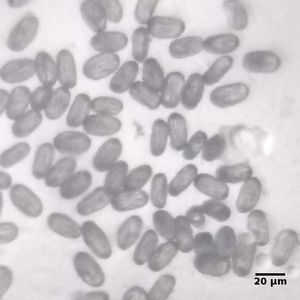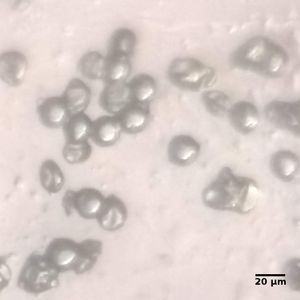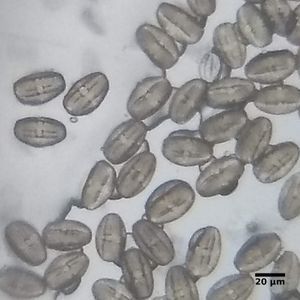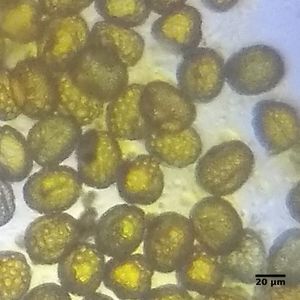Nagalingam Pollen — diversity in the SAME flower!
 May 28, 2018 • 10:27 AM UTC
May 28, 2018 • 10:27 AM UTC Unknown Location
Unknown Location 140x Magnification
140x Magnification Microorganisms
Microorganisms
varuni
Learn about the author...
21posts
22comments
1locations

There’s a small dense grove of Nagalingam ( Couroupita guianensis ) trees on campus. Here’s one of the trees with its many low thin bare branches:
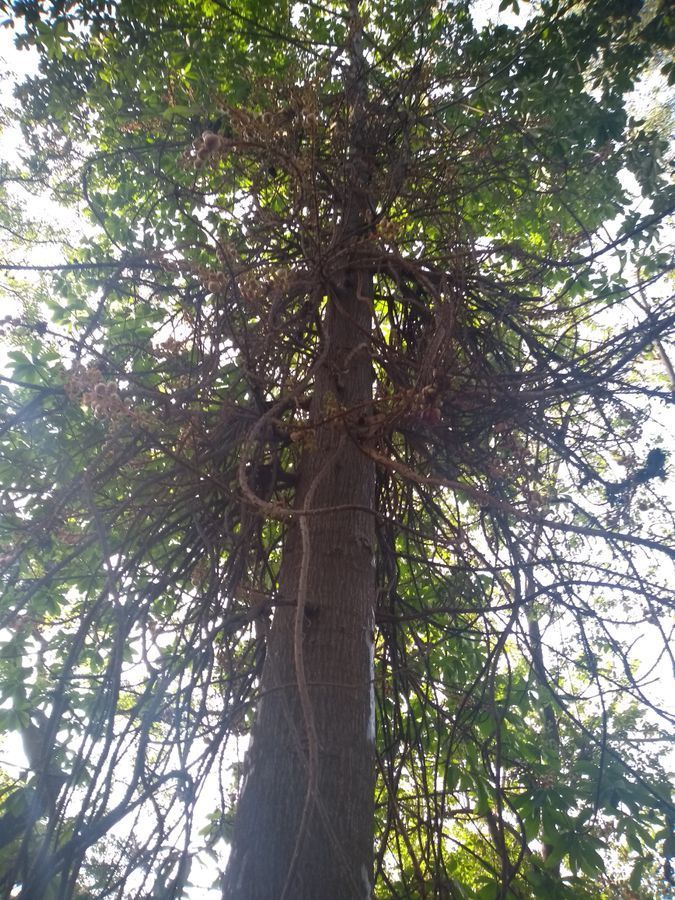
There’s a lovely indescribable sweet but not quite saccharine fragrance as you walk by.

Here’s one of the thick and rubbery fallen flowers:
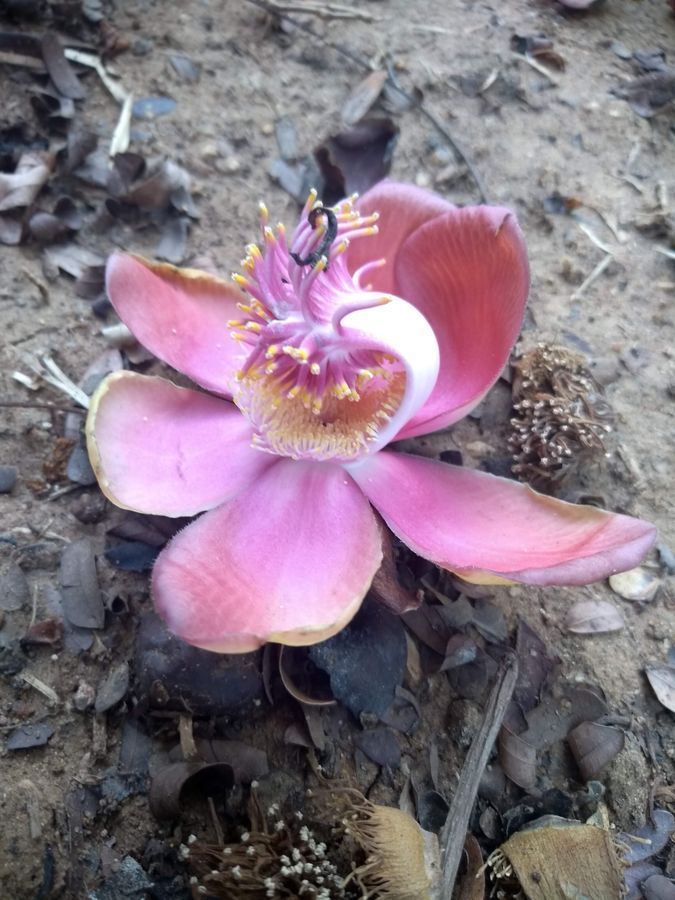
So I picked up one of these flowers and squashed an anther onto a slide to view under the Foldscope. And here’s what I saw:


They look to me like tetrad pollen! (Some of them may look like there are only 3, but I think the 4th one is out of focus. You can sort of see a dark blotch where the fourth one is.) Each of the pollen grains in the tetrad are about 20 microns in length and 10 microns wide.
This was already very exciting — I haven’t really seen a lot of tetrad pollen (other than possibly in Seethapzham , which was not very convincing since there were very few pollen to see anyway.)
But then, just before I threw out the flower, I broke off the ‘hood’. (In fact, in many Indian languages, the name of this tree is some derivative of nag or snake since the flower has this Cobra hood like structure.)
This was already very exciting — I haven’t really seen a lot of tetrad pollen (other than possibly in Seethapzham , which was not very convincing since there were very few pollen to see anyway.)
But then, just before I threw out the flower, I broke off the ‘hood’. (In fact, in many Indian languages, the name of this tree is some derivative of nag or snake since the flower has this Cobra hood like structure.)

To my surprise I discovered that what I assumed to be pistils seemed like more anthers?! Here are is the base filament/pistil next to what are clearly recognizable as filaments with anthers:

I squashed the tip of the smaller unknown thing on a slide, expecting to see some sticky stigma, but instead, saw this:

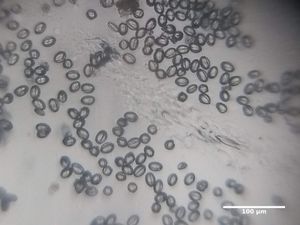
MORE POLLEN?? Definitely not tetrads though!
By my estimate these are also 20 microns in length and 10 microns in diameter — probably also pollen. These pollen seem to be about the same size as the individual pollen in the tetrad pollen (for comparison, notice in the top right side of the first image: a tetrad pollen that has snuck in). The tetrad pollen is somewhat darker too.
I took an image of a single squashed small undetermined thing just to confirm that I wasn’t somehow breaking up the tetrads:
By my estimate these are also 20 microns in length and 10 microns in diameter — probably also pollen. These pollen seem to be about the same size as the individual pollen in the tetrad pollen (for comparison, notice in the top right side of the first image: a tetrad pollen that has snuck in). The tetrad pollen is somewhat darker too.
I took an image of a single squashed small undetermined thing just to confirm that I wasn’t somehow breaking up the tetrads:

Here are the two types of pollen side by side:
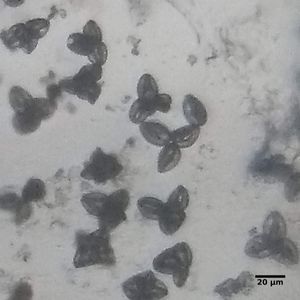

Maybe one of the pollen types are just not mature yet?? Maybe the tetrads break up when they reach the stigma? The end of the smaller undetermined thing definitely looked more like an anther than a hairy, sticky stigma though…
I went back to the tree and got a good look at the that thin low branches that hold flowers.
I went back to the tree and got a good look at the that thin low branches that hold flowers.

It seemed like once the flower wilts and falls, the pistil stays on the tree (you can see them here above the open flower). So maybe these base thingis actually hold different anthers?
A few Google searchs later, I found that dimorphic anthers and pollen is a known feature of the flowers of Lecythidaceae
or the Brazil nut family and one of its members is our Nagalingam . (If pollinated, the fertilized ovaries left on the tree will develop into a cannon ball like fruit which is where the tree gets its English name: Cannon Ball tree ). The flowers do not have any nectar and pollinators (mainly Carpenter bees) are attracted to the flower for its special pollen — the tetrad form on the hood — which they collect to feed to their larvae. These tetrad hood pollen however, are infertile and do not germinate. The base (or ring) anthers have fertile monoid pollen. So when the bees come to collect larvae food (infertile pollen), their head and back are dusted with the fertile pollen which they will then deposit on another flower they visit to harvest more food!
Now I am wondering what other dimorphic pollen I missed because I only looked at one side of a flower or one anther of one side of a flower (not to mention just one flower )! I am especially thinking about my last post about Indian Laburnum which definitely has dimorphic anthers — but is the pollen dimorphic too?? Stay tuned… will check and post soon.
I hope some of these amazing evolutionarily crafted flowers are still in bloom when I start working with school students next week when schools reopen……..
PS – Check out a full list of pollen I have been observing:
Pollen list
This post is open to read and review on The Winnower.
A few Google searchs later, I found that dimorphic anthers and pollen is a known feature of the flowers of Lecythidaceae
or the Brazil nut family and one of its members is our Nagalingam . (If pollinated, the fertilized ovaries left on the tree will develop into a cannon ball like fruit which is where the tree gets its English name: Cannon Ball tree ). The flowers do not have any nectar and pollinators (mainly Carpenter bees) are attracted to the flower for its special pollen — the tetrad form on the hood — which they collect to feed to their larvae. These tetrad hood pollen however, are infertile and do not germinate. The base (or ring) anthers have fertile monoid pollen. So when the bees come to collect larvae food (infertile pollen), their head and back are dusted with the fertile pollen which they will then deposit on another flower they visit to harvest more food!
Now I am wondering what other dimorphic pollen I missed because I only looked at one side of a flower or one anther of one side of a flower (not to mention just one flower )! I am especially thinking about my last post about Indian Laburnum which definitely has dimorphic anthers — but is the pollen dimorphic too?? Stay tuned… will check and post soon.
I hope some of these amazing evolutionarily crafted flowers are still in bloom when I start working with school students next week when schools reopen……..
PS – Check out a full list of pollen I have been observing:
Pollen list
This post is open to read and review on The Winnower.
Sign in to commentNobody has commented yet... Share your thoughts with the author and start the discussion!
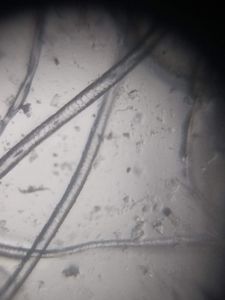
 0 Applause
0 Applause 0 Comments
0 Comments
